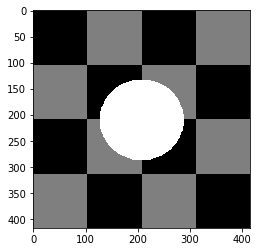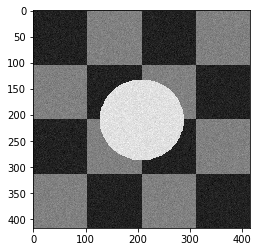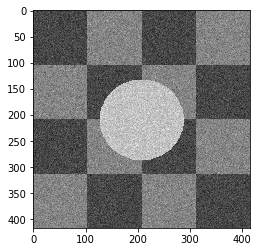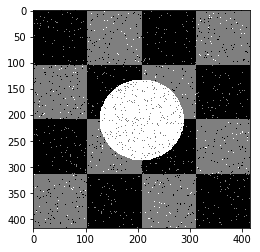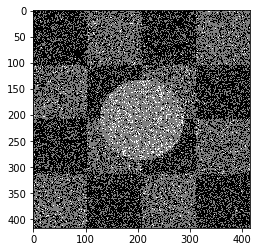This project has two parts. In part one, we use a Markov random field Model to denoise an image. In Part two, we use a similar model for image segmentation.
In this part, we have an image. We add a gussian noise to it. Then we use markov model
Import Libraries
from PIL import Image
import numpy as np
import pandas as pd
import os, os.path
from scipy import misc
import glob
import sys
from matplotlib.pyplot import imshow
import imageio
import scipy.stats
import matplotlib.pyplot as plt
import matplotlib.image as mpimg
from scipy import optimize
import random
np.seterr(all='raise');
import warnings
warnings.filterwarnings('ignore')path = './test1.bmp'
arr = misc.imread(path, flatten=True)
labels = np.array(arr / 127, dtype=int)
print ("initial image")
imshow(arr, cmap='gray');initial image
tmp = plt.gcf().clear()<matplotlib.figure.Figure at 0xa6cdb79208>
In this part we added noise (with normal distribution) to the image.
def add_noise (arr, var):
noise = np.random.normal(0, np.sqrt(var), arr.shape)
noisy_arr = arr + noise
return noisy_arrdef naive_bayes_learning(arr, noisy_arr, labels):
class_info = []
number_of_pixels = arr.size
for cls in [0,1,2]:
tmp = []
for i in range(0, len(arr)):
for j in range(0, len(arr[0])):
if (labels[i][j]==cls):
tmp.append(noisy_arr[i][j])
tmp = np.asarray(tmp)
class_mean = np.mean(tmp)
class_var = np.var(tmp)
class_freq = len(tmp)
class_probabilty = class_freq/number_of_pixels
class_info.append([class_probabilty, class_mean, class_var])
return class_infoNormal PDF
def pdf_of_normal(x, mean, var):
return (1/np.sqrt(2 * np.pi * var))*np.exp(-((x-mean)**2)/(2*var))We used naive bayes classifier for predicting the real label of each pixel
def naive_bayes_predict (arr, class_info, fixed_pixels_index=[], correct_arr = []):
predict_array = np.zeros((len(arr), len(arr[0])), dtype=float)
class_color = [0,127,255]
for i in range(0, len(arr)):
for j in range(0, len(arr[0])):
if (len(fixed_pixels_index)>0 and len(correct_arr)>0 and fixed_pixels_index[i][j]==1):
predict_array[i][j]=correct_arr[i][j]
continue
max_probabilty = 0
best_class = -1
val = arr[i][j]
for cls_index in range(len(class_info)):
cls_p = class_info[cls_index][0]
mean = class_info[cls_index][1]
var = class_info[cls_index][2]
pos =pdf_of_normal(val, mean, var)
cls_posterior = cls_p * pos
if (cls_posterior > max_probabilty):
max_probabilty = cls_posterior
best_class = cls_index
predict_array[i][j] = class_color[best_class]
return predict_arrayIn this part, we used Naive Bayes classifier defined in part A to classify true labels for each of the image's pixels.
variance_list = [100, 1000, 20000]
for var in variance_list:
noisy_arr = add_noise(arr, var)
cls_info = naive_bayes_learning(arr, noisy_arr, labels)
prediciton_array = naive_bayes_predict(noisy_arr, cls_info)
print ("Noisy Image with var", var)
plt.imshow(noisy_arr, cmap='gray')
plt.show()
print ("Naive Bayes Classifier Labels")
plt.imshow(prediciton_array, cmap='gray')
plt.show()Noisy Image with var 100
Naive Bayes Classifier Labels
Noisy Image with var 1000
Naive Bayes Classifier Labels
Noisy Image with var 20000
Naive Bayes Classifier Labels
As you can see the results, this approach worked well when the noise variance is 10, but when the noise increases, this approach didn't work well.
Markov Random Field Models provide a simple and effective way to model the spatial dependencies in image pixels.
So we useed them to model the connection between two neighbour pixels.
In our problem we have to define an energy function on hidden states corresponding to true values of each pixels, then we minimize this function to obtain the best prediction.
Our energy function is defined as below:
def distance (x,y):
a = x-y
a = a*a
return np.sqrt(np.sum(a))def differnce(a,b):
if (a==b):
return -1
else:
return 1def initial_energy_function(initial_w, pixels, betha, cls_info, neighbors_indices):
w = initial_w
energy = 0.0
rows = len(w)
cols = len(w[0])
for i in range(0, len(w)):
for j in range(0, len(w[0])):
mean = cls_info[int (w[i][j])][1]
var = cls_info[int (w[i][j])][2]
energy += np.log(np.sqrt(2*np.pi*var))
energy += ((pixels[i][j]-mean)**2)/(2*var)
for a,b in neighbors_indices:
a +=i
b +=j
if 0<=a<rows and 0<=b<cols:
energy += betha * differnce(w[i][j], w[a][b])
return energydef exponential_schedule(step_number, current_t, initial_temp, constant=0.99):
return current_t*constant
def logarithmical_multiplicative_cooling_schedule(step_number, current_t, initial_temp, constant=1.0):
return initial_temp / (1 + constant * np.log(1+step_number))
def linear_multiplicative_cooling_schedule(step_number, current_t, initial_temp, constant=1.0):
return initial_temp / (1 + constant * step_number)def delta_enegry(w, index, betha, new_value, neighbors_indices, pixels, cls_info):
initial_energy = 0
(i,j) = index
rows = len(w)
cols = len(w[0])
mean = cls_info[int(w[i][j])][1]
var = cls_info[int(w[i][j])][2]
initial_energy += np.log(np.sqrt(2*np.pi*var))
initial_energy += ((pixels[i][j]-mean)**2)/(2*var)
for a,b in neighbors_indices:
a +=i
b +=j
if 0<=a<rows and 0<=b<cols:
initial_energy += betha * differnce(w[i][j], w[a][b])
new_energy = 0
mean = cls_info[new_value][1]
var = cls_info[new_value][2]
new_energy += np.log(np.sqrt(2*np.pi*var))
new_energy += ((pixels[i][j]-mean)**2)/(2*var)
# print("/////// \n first enegry", new_energy)
for a,b in neighbors_indices:
a +=i
b +=j
if 0<=a<rows and 0<=b<cols:
new_energy += betha * differnce(new_value, w[a][b])
# print ("END energy", new_energy)
return new_energy - initial_energydef simulated_annealing(init_w, class_labels, temprature_function,
pixels, betha, cls_info, neighbors_indices, max_iteration=10000,
initial_temp = 1000, known_index=[], correct_arr = [], temprature_function_constant=None ):
partial_prediction=False
if (len(known_index)>0 and len(correct_arr)>0):
partial_prediction=True
w = np.array(init_w)
changed_array = np.zeros((len(w), len(w[0])))
iteration =0
x = len(w)
y = len(w[0])
current_energy = initial_energy_function(w, pixels, betha, cls_info, neighbors_indices)
current_tmp = initial_temp
while (iteration<max_iteration):
if (partial_prediction):
is_found=False
while (is_found==False):
i = random.randint(0, x-1)
j = random.randint(0, y-1)
if (known_index[i][j]==0):
is_found=True
else:
i = random.randint(0, x-1)
j = random.randint(0, y-1)
l = list(class_labels)
l.remove(w[i][j])
r = random.randint(0, len(l)-1)
new_value = l[r]
delta = delta_enegry(w, (i,j), betha, new_value, neighbors_indices, pixels, cls_info)
r = random.uniform(0, 1)
if (delta<=0):
w[i][j]=new_value
current_energy+=delta
changed_array[i][j]+=1
# print ("CHANGED better")
else:
try:
if (-delta / current_tmp < -600):
k=0
else:
k = np.exp(-delta / current_tmp)
except:
k=0
if r < k:
# print("CHANGED worse")
w[i][j] = new_value
current_energy += delta
changed_array[i][j] += 1
if (temprature_function_constant!=None):
current_tmp = temprature_function(iteration, current_tmp, initial_temp, constant =temprature_function_constant)
else:
current_tmp = temprature_function(iteration, current_tmp, initial_temp)
iteration+=1
return w, changed_arraydef convert_to_class_labels(arr, inverse_array={0:0, 127:1, 255:2}):
for i in range(0, len(arr)):
for j in range(0, len(arr[0])):
arr[i][j] = inverse_array[int(arr[i][j])]def get_accuracy(arr, labels):
correct = 0
for i in range(0, len(arr)):
for j in range(0, len(arr[0])):
if (labels[i][j]==int(arr[i][j]/127)):
correct+=1
return correct/(len(arr[0])*len(arr))# plt.close('all')
def a_complete_set_for_part_1 (arr, max_iter=1000000,var = 10000,
betha = 100,
neighbor_indices = [[0,1],[0,-1],[1,0],[-1,0]],
class_labels = [0,1,2],
class_color = [0,127,255],
schedule= exponential_schedule,
temprature_function_constant=None):
fig, (ax1, ax2, ax3, ax4) = plt.subplots(1,4)
# fig.suptitle('Comparision', fontsize=20)
noisy_arr = add_noise(arr, var)
ax1.set_title('Noisy image \n accuracy '+str(get_accuracy(noisy_arr, labels)))
ax1.imshow(noisy_arr, cmap='gray')
rows = len(noisy_arr)
cols = len(noisy_arr[0])
cls_info = naive_bayes_learning(arr, noisy_arr, labels)
initial_arr = naive_bayes_predict(noisy_arr, cls_info)
ax2.set_title('Naive Bayes image \n accuracy '+str(get_accuracy(initial_arr, labels)))
ax2.imshow(initial_arr, cmap='gray')
convert_to_class_labels(initial_arr)
w, test_array = simulated_annealing(initial_arr, class_labels, schedule,
noisy_arr, betha, cls_info, neighbor_indices, max_iteration=max_iter)
for i in range (0, len(w)):
for j in range(0, len(w[0])):
w[i][j] = class_color[int (w[i][j])]
ax3.set_title('CRF image \n accuracy '+str(get_accuracy(w, labels)))
ax3.imshow(w, cmap='gray')
plt.rcParams["figure.figsize"] = (20,3)
ax4.set_title('differ image')
ax4.imshow(test_array, cmap='gray')
plt.show()We used naive bayes results of Part B as the initial state for the true pixels values. Then we used simulated annealing optimization method. We tested different hyper pararmeters to compare the performance of the MRF models with naive bayes model.
plt.figure(figsize=(10, 12), dpi=80, facecolor='w', edgecolor='k')<matplotlib.figure.Figure at 0xa6cdaeb2b0>
<matplotlib.figure.Figure at 0xa6cdaeb2b0>
a_complete_set_for_part_1(arr, max_iter=1e4, var=1e4, betha=1e2)a_complete_set_for_part_1(arr, max_iter=1e6, var=1e4, betha=1e2)a_complete_set_for_part_1(arr, max_iter=1e6, var=1e4, betha=1e4)a_complete_set_for_part_1(arr, max_iter=1e7, var=1e4, betha=1e4)We compared two different modes. First mode uses only four neighbors pixels. Second mode uses eight neighbors pixels in the model. The result is as below.
plt.figure(figsize=(10, 12), dpi=80, facecolor='w', edgecolor='k')
a_complete_set_for_part_1(arr, max_iter=1e6, var=1e4, betha=1e4)<matplotlib.figure.Figure at 0x835c997d30>
eight_neighbors_indices = [[0,1],[0,-1],[1,0],[-1,0],[1,1],[1,-1],[-1,1],[-1,-1]]
a_complete_set_for_part_1(arr, max_iter=1e6, var=1e4, betha=1e4, neighbor_indices=eight_neighbors_indices)<matplotlib.figure.Figure at 0x835cd53d30>
When we used eight neighbours, the smoothness of result increased. The weakness of eight neighbors parameter is that the model can't find a good boundary for the circle in the center. Because circles border are different from rectangles and so the number of same color in the border of circle is less than rectangles border. And the model connot predict well in this situation. If we use lower betha, then the result for the circle is going to be better.
a_complete_set_for_part_1(arr, max_iter=1e6, var=1e4, betha=1e-1, neighbor_indices=eight_neighbors_indices)In this part, we tested different
bta = 1e-4
print ("Betha", bta)
a_complete_set_for_part_1(arr, max_iter=1e6, var=1e4, betha=bta)Betha 0.0001
bta = 1e-3
print ("Betha", bta)
a_complete_set_for_part_1(arr, max_iter=1e6, var=1e4, betha=bta)Betha 0.001
bta = 1e-2
print ("Betha", bta)
a_complete_set_for_part_1(arr, max_iter=1e6, var=1e4, betha=bta)Betha 0.01
bta = 1e-1
print ("Betha", bta)
a_complete_set_for_part_1(arr, max_iter=1e6, var=1e4, betha=bta)Betha 0.1
bta = 1e0
print ("Betha", bta)
a_complete_set_for_part_1(arr, max_iter=1e6, var=1e4, betha=bta)Betha 1.0
bta = 1e1
print ("Betha", bta)
a_complete_set_for_part_1(arr, max_iter=1e6, var=1e4, betha=bta)Betha 10.0
bta = 1e2
print ("Betha", bta)
a_complete_set_for_part_1(arr, max_iter=1e6, var=1e4, betha=bta)Betha 100.0
bta = 1e4
print ("Betha", bta)
a_complete_set_for_part_1(arr, max_iter=1e6, var=1e4, betha=bta)Betha 10000.0
xs = [-4,-3,-2,-1,0,1,2,4]
accs = [0.623, 0.627, .633, .729, .8587, .8581, .8552, .8551]
plt.plot(xs, accs)
plt.show()According to the above graph, the best
In this part, we have some part of the image and we want to predict the remaining part.
def a_complete_set_for_part_1_some_pixels_known (arr,known_index, max_iter=1000000,var = 10000,
betha = 100,
neighbor_indices = [[0,1],[0,-1],[1,0],[-1,0]],
class_labels = [0,1,2],
class_color = [0,127,255],
schedule= exponential_schedule
,temprature_function_constant=None):
fig, (ax1, ax2, ax3, ax4) = plt.subplots(1,4)
# fig.suptitle('Comparision', fontsize=20)
noisy_arr = add_noise(arr, var)
for i in range(0, len(arr)):
for j in range(0, len(arr[0])):
if (known_index[i][j]==1):
noisy_arr[i][j]=arr[i][j]
ax1.set_title('Noisy image \n accuracy '+str(get_accuracy(noisy_arr, labels)))
ax1.imshow(noisy_arr, cmap='gray')
rows = len(noisy_arr)
cols = len(noisy_arr[0])
cls_info = naive_bayes_learning(arr, noisy_arr, labels)
initial_arr = naive_bayes_predict(noisy_arr, cls_info, fixed_pixels_index=known_index, correct_arr = arr)
ax2.set_title('Naive Bayes image \n accuracy '+str(get_accuracy(initial_arr, labels)))
ax2.imshow(initial_arr, cmap='gray')
convert_to_class_labels(initial_arr)
w, test_array = simulated_annealing(initial_arr, class_labels, schedule,
noisy_arr, betha, cls_info, neighbor_indices,
max_iteration=max_iter, known_index=known_index, correct_arr=arr)
for i in range (0, len(w)):
for j in range(0, len(w[0])):
w[i][j] = class_color[int (w[i][j])]
ax3.set_title('CRF image \n accuracy '+str(get_accuracy(w, labels)))
ax3.imshow(w, cmap='gray')
plt.rcParams["figure.figsize"] = (20,3)
ax4.set_title('differ image')
ax4.imshow(test_array, cmap='gray')
plt.show()plt.figure(figsize=(10, 12), dpi=80, facecolor='w', edgecolor='k')
known_index = np.zeros((len(arr), len(arr[0])))
for i in range (0, len(arr)):
for j in range(0, len(arr[0])):
if (i <= j ):
known_index[i][j]=1
bta = 1e4
a_complete_set_for_part_1_some_pixels_known(arr, known_index, max_iter=1e6, var=1e4, betha=bta)<matplotlib.figure.Figure at 0xa6d9bbad68>
In this part, we compared different schedules in simulated annealing optimizer.
We tested different scheduling Strategy. And the result is as follow.
a_complete_set_for_part_1(arr, max_iter=1e6, var=1e4, betha=bta,
schedule=exponential_schedule, temprature_function_constant=0.8)a_complete_set_for_part_1(arr, max_iter=1e6, var=1e4, betha=bta,
schedule=exponential_schedule, temprature_function_constant=0.9)a_complete_set_for_part_1(arr, max_iter=1e6, var=1e4, betha=bta,
schedule=logarithmical_multiplicative_cooling_schedule, temprature_function_constant=1.0)a_complete_set_for_part_1(arr, max_iter=1e6, var=1e4, betha=bta,
schedule=linear_multiplicative_cooling_schedule, temprature_function_constant=1.0)a_complete_set_for_part_1(arr, max_iter=1e6, var=1e4, betha=bta,
schedule=linear_multiplicative_cooling_schedule, temprature_function_constant=0.5)a_complete_set_for_part_1(arr, max_iter=1e6, var=1e4, betha=bta,
schedule=linear_multiplicative_cooling_schedule, temprature_function_constant=1.5)In this part, we used Markov Random Field for image segmentation.
We used different image color space:
- Gray Scale
- HSV
- RGB Format
from PIL import Image
import numpy as np
import pandas as pd
import os, os.path
from scipy import misc
import glob
import sys
from matplotlib.pyplot import imshow
import imageio
import scipy.stats
import matplotlib.pyplot as plt
import matplotlib.image as mpimg
from scipy import optimize
import random
import warnings
warnings.filterwarnings('ignore')
# np.seterr(all='raise');path = "test2-mini.jpg"
arr = misc.imread(path, flatten=True)
print ("initial image")
imshow(arr, cmap='gray');initial image
tmp = plt.gcf().clear()<Figure size 432x288 with 0 Axes>
Getting labels from training data
initial_probability = {"Sky.jpg": 0.30,"Road.jpg": 0.20, "Grass.jpg":0.50}
number_of_pixels = arr.size
class_info = []
paths= ["Sky.jpg", "Road.jpg", "Grass.jpg"]
for path in paths:
tmp_arr = misc.imread(path, flatten=True)
class_mean = np.mean(tmp_arr)
class_var = np.var(tmp_arr)
class_freq = len(tmp_arr)
class_probabilty = class_freq/number_of_pixels
class_info.append([initial_probability[path], class_mean, class_var])
print ("class_info")
print (class_info)class_info
[[0.3, 166.92361, 272.364], [0.2, 95.18236, 964.224], [0.5, 59.97941, 1128.2644]]
Normal PDF
def pdf_of_normal(x, mean, var):
return (1/np.sqrt(2 * np.pi * var))*np.exp(-((x-mean)**2)/(2*var))We used naive bayes classifier for predicting the real label of each pixel
def naive_bayes_predict (arr, class_info, fixed_pixels_index=[], correct_arr = []):
predict_array = np.zeros((len(arr), len(arr[0])), dtype=float)
class_color = [0,127,255]
for i in range(0, len(arr)):
for j in range(0, len(arr[0])):
if (len(fixed_pixels_index)>0 and len(correct_arr)>0 and fixed_pixels_index[i][j]==1):
predict_array[i][j]=correct_arr[i][j]
continue
max_probabilty = 0
best_class = -1
val = arr[i][j]
for cls_index in range(len(class_info)):
cls_p = class_info[cls_index][0]
mean = class_info[cls_index][1]
var = class_info[cls_index][2]
pos =pdf_of_normal(val, mean, var)
cls_posterior = cls_p * pos
if (cls_posterior > max_probabilty):
max_probabilty = cls_posterior
best_class = cls_index
predict_array[i][j] = class_color[best_class]
return predict_arraydef distance (x,y):
a = x-y
a = a*a
return np.sqrt(np.sum(a))def differnce(a,b):
if (a==b):
return -1
else:
return 1def initial_energy_function(initial_w, pixels, betha, cls_info, neighbors_indices):
w = initial_w
energy = 0.0
rows = len(w)
cols = len(w[0])
for i in range(0, len(w)):
for j in range(0, len(w[0])):
mean = cls_info[int (w[i][j])][1]
var = cls_info[int (w[i][j])][2]
energy += np.log(np.sqrt(2*np.pi*var))
energy += ((pixels[i][j]-mean)**2)/(2*var)
for a,b in neighbors_indices:
a +=i
b +=j
if 0<=a<rows and 0<=b<cols:
energy += betha * differnce(w[i][j], w[a][b])
return energydef exponential_schedule(step_number, current_t, initial_temp, constant=0.99):
return current_t*constant
def logarithmical_multiplicative_cooling_schedule(step_number, current_t, initial_temp, constant=1.0):
return initial_temp / (1 + constant * np.log(1+step_number))
def linear_multiplicative_cooling_schedule(step_number, current_t, initial_temp, constant=1.0):
return initial_temp / (1 + constant * step_number)def delta_enegry(w, index, betha, new_value, neighbors_indices, pixels, cls_info):
initial_energy = 0
(i,j) = index
rows = len(w)
cols = len(w[0])
mean = cls_info[int(w[i][j])][1]
var = cls_info[int(w[i][j])][2]
initial_energy += np.log(np.sqrt(2*np.pi*var))
initial_energy += ((pixels[i][j]-mean)**2)/(2*var)
for a,b in neighbors_indices:
a +=i
b +=j
if 0<=a<rows and 0<=b<cols:
initial_energy += betha * differnce(w[i][j], w[a][b])
new_energy = 0
mean = cls_info[new_value][1]
var = cls_info[new_value][2]
new_energy += np.log(np.sqrt(2*np.pi*var))
new_energy += ((pixels[i][j]-mean)**2)/(2*var)
# print("/////// \n first enegry", new_energy)
for a,b in neighbors_indices:
a +=i
b +=j
if 0<=a<rows and 0<=b<cols:
new_energy += betha * differnce(new_value, w[a][b])
# print ("END energy", new_energy)
return new_energy - initial_energydef simulated_annealing(init_w, class_labels, temprature_function,
pixels, betha, cls_info, neighbors_indices, max_iteration=10000,
initial_temp = 1000, known_index=[], correct_arr = [], temprature_function_constant=None ):
partial_prediction=False
if (len(known_index)>0 and len(correct_arr)>0):
partial_prediction=True
w = np.array(init_w)
changed_array = np.zeros((len(w), len(w[0])))
iteration =0
x = len(w)
y = len(w[0])
current_energy = initial_energy_function(w, pixels, betha, cls_info, neighbors_indices)
current_tmp = initial_temp
while (iteration<max_iteration):
if (partial_prediction):
is_found=False
while (is_found==False):
i = random.randint(0, x-1)
j = random.randint(0, y-1)
if (known_index[i][j]==0):
is_found=True
else:
i = random.randint(0, x-1)
j = random.randint(0, y-1)
l = list(class_labels)
l.remove(w[i][j])
r = random.randint(0, len(l)-1)
new_value = l[r]
delta = delta_enegry(w, (i,j), betha, new_value, neighbors_indices, pixels, cls_info)
r = random.uniform(0, 1)
if (delta<=0):
w[i][j]=new_value
current_energy+=delta
changed_array[i][j]+=1
# print ("CHANGED better")
else:
try:
if (-delta / current_tmp < -600):
k=0
else:
k = np.exp(-delta / current_tmp)
except:
k=0
if r < k:
# print("CHANGED worse")
w[i][j] = new_value
current_energy += delta
changed_array[i][j] += 1
if (temprature_function_constant!=None):
current_tmp = temprature_function(iteration, current_tmp, initial_temp, constant =temprature_function_constant)
else:
current_tmp = temprature_function(iteration, current_tmp, initial_temp)
iteration+=1
return w, changed_arraydef convert_to_class_labels(arr, inverse_array={0:0, 127:1, 255:2}):
for i in range(0, len(arr)):
for j in range(0, len(arr[0])):
arr[i][j] = inverse_array[int(arr[i][j])]def get_accuracy(arr, labels):
correct = 0
for i in range(0, len(arr)):
for j in range(0, len(arr[0])):
if (labels[i][j]==int(arr[i][j]/127)):
correct+=1
return correct/(len(arr[0])*len(arr))# plt.close('all')
def a_complete_set_for_part_2 (arr, class_info, max_iter=1000000,var = 10000,
betha = 100,
neighbor_indices = [[0,1],[0,-1],[1,0],[-1,0]],
class_labels = [0,1,2],
class_color = [0,127,255],
schedule= exponential_schedule,
temprature_function_constant=None):
fig, (ax1, ax2, ax3, ax4) = plt.subplots(1,4)
# fig.suptitle('Comparision', fontsize=20)
ax1.set_title("initial image")
ax1.imshow(arr, cmap='gray')
rows = len(arr)
cols = len(arr[0])
# cls_info = naive_bayes_learning(arr, noisy_arr, labels)
cls_info = class_info
initial_arr = naive_bayes_predict(arr, cls_info)
ax2.set_title('Naive Bayes image')
ax2.imshow(initial_arr, cmap='gray')
convert_to_class_labels(initial_arr)
w, test_array = simulated_annealing(initial_arr, class_labels, schedule,
arr, betha, cls_info, neighbor_indices, max_iteration=max_iter)
for i in range (0, len(w)):
for j in range(0, len(w[0])):
w[i][j] = class_color[int (w[i][j])]
ax3.set_title('CRF image')
ax3.imshow(w, cmap='gray')
plt.rcParams["figure.figsize"] = (20,3)
ax4.set_title('differ image')
ax4.imshow(test_array, cmap='gray')
plt.show()plt.figure(figsize=(16, 18), dpi=80, facecolor='w', edgecolor='k')<Figure size 1280x1440 with 0 Axes>
<Figure size 1280x1440 with 0 Axes>
plt.figure(figsize=(16, 18), dpi=80, facecolor='w', edgecolor='k')
a_complete_set_for_part_2(arr,class_info, max_iter=1e4, betha=1e4)<Figure size 1280x1440 with 0 Axes>
a_complete_set_for_part_2(arr,class_info, max_iter=1e4, betha=1e6)a_complete_set_for_part_2(arr,class_info, max_iter=1e6, betha=1e6)a_complete_set_for_part_2(arr,class_info, max_iter=1e7, betha=1e6)Now we want to use HSV color space for training our data.
import matplotlib
path = "test2-mini.jpg"
img = Image.open(path)
hsv_arr = matplotlib.colors.rgb_to_hsv(img)
hsv_arr = np.asarray(hsv_arr)
h_arr = hsv_arr[:,:,0]
plt.imshow(h_arr, cmap="gray")
plt.show()def read_image_h(path):
img = Image.open(path)
hsv_arr = matplotlib.colors.rgb_to_hsv(img)
hsv_arr = np.asarray(hsv_arr)
h_arr = hsv_arr[:,:,0]
# plt.imshow(h_arr, cmap="gray")
# plt.show()
return 256*h_arrinitial_probability = {"Sky.jpg": 0.30,"Road.jpg": 0.20, "Grass.jpg":0.50}
number_of_pixels = arr.size
class_info = []
paths= ["Sky.jpg", "Road.jpg", "Grass.jpg"]
for path in paths:
tmp_arr = read_image_h(path)
class_mean = np.mean(tmp_arr)
class_var = np.var(tmp_arr)
class_freq = len(tmp_arr)
class_probabilty = class_freq/number_of_pixels
class_info.append([initial_probability[path], class_mean, class_var])
print ("class_info")
print (class_info)class_info
[[0.3, 151.39041, 2.6179988], [0.2, 64.93362, 6850.9604], [0.5, 67.78984, 159.66528]]
plt.figure(figsize=(16, 18), dpi=80, facecolor='w', edgecolor='k')<Figure size 1280x1440 with 0 Axes>
<Figure size 1280x1440 with 0 Axes>
arr_h = read_image_h("test2-mini.jpg")plt.figure(figsize=(16, 18), dpi=80, facecolor='w', edgecolor='k')
a_complete_set_for_part_2(arr_h,class_info, max_iter=1e2, betha=1e4)<Figure size 1280x1440 with 0 Axes>
a_complete_set_for_part_2(arr_h,class_info, max_iter=1e4, betha=1e4)a_complete_set_for_part_2(arr_h,class_info, max_iter=1e6, betha=1e4)a_complete_set_for_part_2(arr_h,class_info, max_iter=1e6, betha=1e6)In this part, we used RGB color format in training since there is some information that can be captured by pixels colors.
We used RGB values in potential function.
def get_class_info_color(img_path, color_index,
paths=["Sky.jpg", "Road.jpg", "Grass.jpg"],
initial_probability={"Sky.jpg": 0.30,"Road.jpg": 0.20, "Grass.jpg":0.50}):
arr_general = misc.imread(img_path)
arr = arr_general[:,:,color_index]
number_of_pixels = arr.size
class_info = []
paths= ["Sky.jpg", "Road.jpg", "Grass.jpg"]
for path in paths:
tmp_arr = misc.imread(path)
tmp_arr = tmp_arr[:,:,color_index]
class_mean = np.mean(tmp_arr)
class_var = np.var(tmp_arr)
class_freq = len(tmp_arr)
# class_probabilty = class_freq/number_of_pixels
class_info.append([initial_probability[path], class_mean, class_var])
return class_infodef naive_bayes_predict_3_color (arr, class_infos, fixed_pixels_index=[], correct_arr = []):
predict_array = np.zeros((len(arr), len(arr[0])), dtype=float)
class_color = [0,127,255]
for i in range(0, len(arr)):
for j in range(0, len(arr[0])):
if (len(fixed_pixels_index)>0 and len(correct_arr)>0 and fixed_pixels_index[i][j]==1):
predict_array[i][j]=correct_arr[i][j]
continue
max_probabilty = 0
best_class = -1
for cls_index in range(0, len(class_color)):
cls_posterior = class_infos[0][cls_index][0]
for c in range(0, 3):#for RGB
val = arr[i][j][c]
class_info = class_infos[c]
mean = class_info[cls_index][1]
var = class_info[cls_index][2]
pos =pdf_of_normal(val, mean, var)
cls_posterior *= pos
if (cls_posterior > max_probabilty):
max_probabilty = cls_posterior
best_class = cls_index
predict_array[i][j] = class_color[best_class]
return predict_arraydef initial_energy_function_colored(initial_w, pixels, betha, cls_infos, neighbors_indices):
w = initial_w
energy = 0.0
rows = len(w)
cols = len(w[0])
for i in range(0, len(w)):
for j in range(0, len(w[0])):
for c in [0,1,2]:
cls_info = cls_infos[c]
mean = cls_info[int (w[i][j])][1]
var = cls_info[int (w[i][j])][2]
pixel_value = pixels[i][j][c]
energy += np.log(np.sqrt(2*np.pi*var))
energy += ((pixel_value-mean)**2)/(2*var)
for a,b in neighbors_indices:
a +=i
b +=j
if 0<=a<rows and 0<=b<cols:
energy += betha * differnce(w[i][j], w[a][b])
return energydef delta_enegry_colored(w, index, betha, new_value, neighbors_indices, pixels, cls_infos):
initial_energy = 0
(i,j) = index
rows = len(w)
cols = len(w[0])
for c in [0,1,2]:
cls_info = cls_infos[c]
mean = cls_info[int(w[i][j])][1]
var = cls_info[int(w[i][j])][2]
pixel_value = pixels[i][j][c]
initial_energy += np.log(np.sqrt(2*np.pi*var))
initial_energy += ((pixel_value-mean)**2)/(2*var)
for a,b in neighbors_indices:
a +=i
b +=j
if 0<=a<rows and 0<=b<cols:
initial_energy += betha * differnce(w[i][j], w[a][b])
new_energy = 0
for c in [0,1,2]:
cls_info = cls_infos[c]
mean = cls_info[new_value][1]
var = cls_info[new_value][2]
pixel_value = pixels[i][j][c]
new_energy += np.log(np.sqrt(2*np.pi*var))
new_energy += ((pixel_value-mean)**2)/(2*var)
# print("/////// \n first enegry", new_energy)
for a,b in neighbors_indices:
a +=i
b +=j
if 0<=a<rows and 0<=b<cols:
new_energy += betha * differnce(new_value, w[a][b])
# print ("END energy", new_energy)
return new_energy - initial_energydef simulated_annealing_colored(init_w, class_labels, temprature_function,
pixels, betha, cls_infos, neighbors_indices, max_iteration=10000,
initial_temp = 1000, known_index=[], correct_arr = [], temprature_function_constant=None ):
partial_prediction=False
if (len(known_index)>0 and len(correct_arr)>0):
partial_prediction=True
w = np.array(init_w)
changed_array = np.zeros((len(w), len(w[0])))
iteration =0
x = len(w)
y = len(w[0])
current_energy = initial_energy_function_colored(w, pixels, betha, cls_infos, neighbors_indices)
current_tmp = initial_temp
while (iteration<max_iteration):
if (partial_prediction):
is_found=False
while (is_found==False):
i = random.randint(0, x-1)
j = random.randint(0, y-1)
if (known_index[i][j]==0):
is_found=True
else:
i = random.randint(0, x-1)
j = random.randint(0, y-1)
l = list(class_labels)
l.remove(w[i][j])
r = random.randint(0, len(l)-1)
new_value = l[r]
delta = delta_enegry_colored(w, (i,j), betha, new_value, neighbors_indices, pixels, cls_infos)
r = random.uniform(0, 1)
if (delta<=0):
w[i][j]=new_value
current_energy+=delta
changed_array[i][j]+=1
# print ("CHANGED better")
else:
try:
if (-delta / current_tmp < -600):
k=0
else:
k = np.exp(-delta / current_tmp)
except:
k=0
if r < k:
# print("CHANGED worse")
w[i][j] = new_value
current_energy += delta
changed_array[i][j] += 1
if (temprature_function_constant!=None):
current_tmp = temprature_function(iteration, current_tmp, initial_temp, constant =temprature_function_constant)
else:
current_tmp = temprature_function(iteration, current_tmp, initial_temp)
iteration+=1
return w, changed_arraydef a_complete_set_for_part_2_3_color (max_iter=1000000, var = 10000,
betha = 100,
neighbor_indices = [[0,1],[0,-1],[1,0],[-1,0]],
class_labels = [0,1,2],
class_color = [0,127,255],
schedule= exponential_schedule,
temprature_function_constant=None,
image_path = "test2-mini.jpg"):
fig, (ax1, ax2, ax3, ax4) = plt.subplots(1,4)
# fig.suptitle('Comparision', fontsize=20)
arr = misc.imread(image_path)
ax1.set_title("initial image")
ax1.imshow(arr)
# cls_info = naive_bayes_learning(arr, noisy_arr, labels)
cls_infos = []
for c in [0,1,2]:
tmp_info =get_class_info_color(image_path,c)
cls_infos.append(tmp_info)
initial_arr = naive_bayes_predict_3_color(arr, cls_infos)
ax2.set_title('Naive Bayes image')
ax2.imshow(initial_arr, cmap='gray')
convert_to_class_labels(initial_arr)
w, test_array = simulated_annealing_colored(initial_arr, class_labels, schedule,
arr, betha, cls_infos, neighbor_indices, max_iteration=max_iter)
for i in range (0, len(w)):
for j in range(0, len(w[0])):
w[i][j] = class_color[int (w[i][j])]
ax3.set_title('CRF image')
ax3.imshow(w, cmap='gray')
plt.rcParams["figure.figsize"] = (20,3)
ax4.set_title('differ image')
ax4.imshow(test_array, cmap='gray')a_complete_set_for_part_2_3_color(max_iter=1e2, betha=1e4)a_complete_set_for_part_2_3_color(max_iter=1e4, betha=1e4)a_complete_set_for_part_2_3_color(max_iter=1e6, betha=1e4)a_complete_set_for_part_2_3_color(max_iter=1e6, betha=1e6)a_complete_set_for_part_2_3_color(max_iter=1e6, betha=1e6,
schedule=linear_multiplicative_cooling_schedule, temprature_function_constant=0.5)np.seterr(all='raise');
a_complete_set_for_part_2_3_color(max_iter=1e6, betha=1e6,
schedule=linear_multiplicative_cooling_schedule, temprature_function_constant=0.5)Grayscale image format didn't have sufficient information for CRF models in this task.
The value H in HSV image format had better information for segmentation using CRF models. And the result was better.
The RGB format also had good information for segmenting the image. Because these three segments have different colors. So if a CRF model considers colors of the image for classification, then the result is going to be better compared to Grayscale images.
